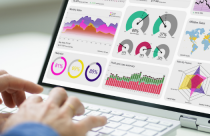Research Data Collection Tips While Social Distancing

The world is in lockdown and the way we knew life will be forever changed after the lockdown. Quarantine forced many research labs to close their doors suddenly. There is no certainty as to when they will be allowed to open again. This means abrupt halting of a lot of scientific research, especially if you’re in the data collection stages of your research project.
You can, however, make your time working from home productive. Now is a good time to review your research project and create a checklist of the requirements for your manuscript. It is also a good time to explore E-books that can help your research. Many of us have been forced to rethink the way we do things. We have moved online! If, like me, you are in the early stages of a qualitative research project, you were probably preparing for data collection. Time and funding pressures mean we cannot simply wait for life to get back to normal, we need to adapt. Let me tell you how I am planning to solve my data collection troubles.
Adapt Your Data Collection Method
I made the decision to re-design my data collection methodology. My initial research proposal was to collect my data through face-to-face interviews with people. I wanted to collect my data in this way so that I could explain my questions to my participants if needed, and to talk to them and gain insight into their thought processes, rather than just their answers. I also wanted to observe their body language to gain a deeper understanding of their responses.
However, I couldn’t do so. Luckily, I have several options to consider:
Video-calls
This was my first solution. Conducting interviews via Zoom or Skype would be just as good as face-to-face interviews. Video-calling ticked all the boxes. Except one…unfortunately, my participants live in rural areas and have limited access to WIFI.
Analyze Blogs
I could change my research sample slightly. Rather than interviewing people, I could research blogs that people write. The blogging community provide a wealth of insights in many different fields. Blogs often allow the authors to express their opinions. It would be difficult to draw conclusions from such a diverse data set though. Therefore, I would set out clear criteria of blogs that are included in my research study.
Open-ended Surveys
I could design a questionnaire with different types of questions. It would be an online survey using software such as Survey Monkey. The types of questions could include some that require a simple yes or no answer; in some cases, the participant may respond through a score how they feel from 1 to 5; and in some participants could elaborate on their views and any of the previous answers. In this way, the participant could tell me their views, how they feel, as well as their reasons for their answers.
Text Messaging
Although my research participants have limited WIFI access, they all own cell phones. I could design a series of USSD codes in which a question is asked, and several options are given for an answer. Scoring-type questions would work well here, where a participant could rate the way they feel about something by selecting a series of numbers, ranging from 1 (highly disagree) to 5 (agree wholeheartedly). The use of text messages limits the number of characters you can use. Therefore, questions need to be phrased carefully to avoid misunderstandings and to keep the participant interested to prevent them from opting out of the survey.
Social Media
People are likely to spend more time on social media during lockdown. I could target a large number of people through a social media post where I ask them to take part in my survey. It would have to be designed in a fun and interesting way to keep participants interested. I could ask participants to respond to some questions with Emoji’s, as an alternative to observing body language. Software such as Doodly or Visme could help me animate my post. This also gives me the option of asking my participants to share the posts with their friends.
Shortcomings to Consider
Before I make my final decision, there are some disadvantages to consider. For example, context is important. The Covid19 pandemic has added a potential variable to my dataset. People are stressed and worried. The way they see life at the moment may not reflect their opinions when they are not under this pressure.
I also need to contact my ethics committee to find out if any of my proposed changes in methodology will affect the ethics of my research. One needs to be careful not to invade people’s privacy or put extra pressure on a certain group of people such as healthcare workers who are working extremely hard at the moment. I must confirm the correct procedure for obtaining permission from participants, where previously I was going to talk them through the process and ask them to sign a consent form. This needs to meet the criteria of the ethics committee.
Changing face-to-face interviews to surveys makes anonymity possible. People’s responses are often different when they are anonymous. I will have to factor this into my analysis. At the same time, I need to ensure the participants meet the criteria of my research group.
Qualitative research is criticized for focusing on experiences. These can be difficult to analyze. Moreover, one needs to ensure there are enough participants that are representative of the population study. Results from small sample sizes cannot simply be generalized to the larger population.
It is, however, possible to adapt your research methodology and continue to collect data during lockdown for qualitative research. I will be looking into these methods to collect research data. What are the methods you have used to collect data during this period? Please let us know your thoughts in the comments section below.










Thank you for providing the best blog for data collection while social distancing this is your blog post is very helpful to us.